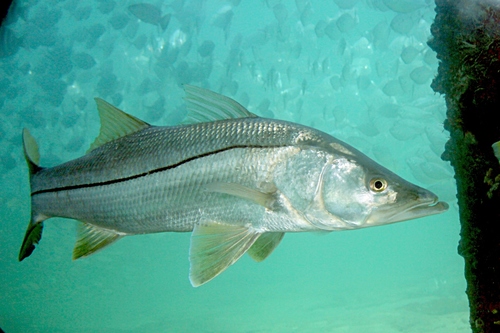
Common Snook
The Bluefin Tuna (Thunnus) is a group of large, powerful, and highly migratory fish species prized for their speed, size, and culinary value. They are apex predators in the marine ecosystem.
15 20 years
Lifespan
140 cm
Length
Least Concern
Conservation Status
48 km/h
Swimming speed
Carnivorous
Diet
Local Migration, Estuarine Migration
Migration
Appearance Overview
The Bluefin Tuna is renowned for its large, streamlined body, built for speed and endurance in the open ocean.
Color
Dark metallic blue on top with a silvery underside
Fin arrangement
Two dorsal fins, the first depressible; a series of finlets running from the dorsal and anal fins to the tail.
Body shape
Torpedo-shaped, allowing for efficient movement through water
Length
up to 10 feet (3 meters), commonly 6.5 feet (2 meters)
Weight
up to 1,500 lbs (680 kg), commonly 550 lbs (250 kg)
Diet
Carnivorous, feeding on a variety of fish, squid, crustaceans, and occasionally on zooplankton and benthic animals.
Feeding Behavior
Highly active predator, using speed to chase down prey, often hunting cooperatively in schools to herd and capture smaller fish.
Social Behavior
Highly migratory, forming large schools, especially during spawning season; exhibits complex social behaviors.
Commercial Relevance
Extremely high value, especially in sushi and sashimi markets, where its fatty flesh is considered a delicacy.
Conservation measures
International fishing quotas, catch limits, and monitoring programs; efforts to establish marine protected areas.
Status
Varies by species: Atlantic Bluefin (Endangered), Pacific Bluefin (Vulnerable), Southern Bluefin (Critically Endangered).
Threats
Overfishing driven by high market demand, bycatch in other fisheries, climate change affecting prey distribution and spawning grounds.
Habitat Distribution
Depth Range
0-900 meters (0-3,000 feet); often found in surface waters but capable of diving to considerable depths.
Geographic Range
Atlantic Ocean (including the Mediterranean Sea), Pacific Ocean, and Indian Ocean.
Preferred Environment
Temperate and subtropical waters; open ocean (pelagic) environments, often associated with oceanic currents.
Reproduction and Life Cycle
Breeding Habits
Spawns in specific warm water regions, such as the Gulf of Mexico and the Mediterranean Sea; spawning is often synchronized with lunar cycles.
Development Stages
Eggs hatch into larvae that drift in plankton-rich waters; juveniles grow rapidly, forming schools and migrating with ocean currents.
Fecundity
Females can produce millions of eggs per spawning season, releasing them into the water for external fertilization.
Maturity Age
Varies by species; Atlantic Bluefin typically matures at 4-8 years, while Southern Bluefin may take longer.
Faqs about Common Snook
How fast can Bluefin Tuna swim?
Bluefin tuna are among the fastest fish in the ocean, capable of bursts of speed up to 43 mph (70 km/h).
What is the lifespan of a Bluefin Tuna?
Bluefin tuna can live up to 40 years, though this varies by species and region.
Are Bluefin Tuna warm-blooded?
Yes, Bluefin tuna are warm-blooded, allowing them to maintain a higher body temperature than the surrounding water, which aids in their speed and endurance.
How are Bluefin Tuna caught?
Bluefin tuna are caught using various methods, including purse seine nets, longlines, and rod and reel.
Why are Bluefin Tuna endangered?
Overfishing has severely depleted Bluefin tuna populations, driving some species towards endangerment.
How far do Bluefin Tuna migrate?
They migrate across entire oceans, often traveling thousands of miles between feeding and spawning grounds.
Where are Bluefin Tuna found?
Bluefin tuna are found in the Atlantic, Pacific, and Indian Oceans, as well as the Mediterranean Sea.
What do Bluefin Tuna eat?
Their diet includes a wide variety of fish, squid, crustaceans, and occasionally zooplankton.
Copyright @ Nature Style Limited. All Rights Reserved.
 English
English